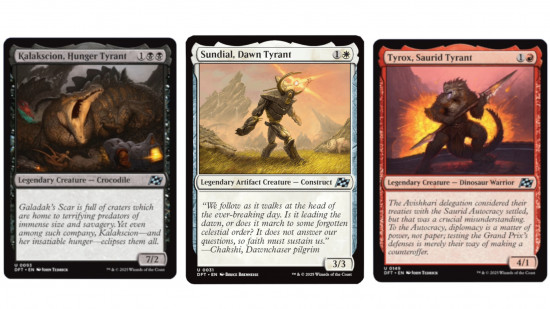The latest Magic: The Gathering set Aetherdrift has a cycle of vanilla creatures that would instill panic in a player from 1993 (though your time machine would probably do that, also). These legendary creatures have no abilities but extremely pushed stats.
Each one hails from Muraganda, one of the MTG planes featured in new set Aetherdrift. A prehistoric world filled with danger and dinosaurs, Muraganda’s whole shtick has been a connection to vanilla creatures, which is one of the reasons it’s never been the main focus of a Magic: The Gathering set up to now – there’s just not much mechanical depth to explore there.
It’ll be interesting to see if any of these creatures, which all feature absurd stats, see play. At a glance, I can see Caelorna is going to be an instant inclusion for any toughness-matters EDH deck, while Terrian could work well alongside Ghalta, Primal Hunger. The others I’m less sure about, though big ups to any mavericks who decide to run one of these as their MTG commander.
In recent years, vanilla creatures have become pretty rare, as Magic has experienced both power and complexity creep. Once upon a time, there’d be vanilla creatures in every set, but now Wizards can go entire years without printing any – and when they do it’s always notable.
Historically, the strength of vanilla creatures has been a good way to measure power creep in Magic – it’s easy to point to a vanilla 4/3 for three and say it’s stronger than a 3/3 with the same mana cost, as there are no other abilities to create ambiguity. For instance, the green/white creature Watchwolf, printing in Ravnica City of Guilds in 2005, was the first time Magic had ever had a basic 3/3 for two mana.
I wonder what a player from 90s or early 2000s would make of any one of these mighty beasts. They would probably assume that they’d dominate every format, rather than being curiosities – novelties for the very fact they lack abilities. The simple fact is interaction in Magic is so strong now that boosted stats usually aren’t enough to cut it.
Each one of the vanilla legends cycle comes with lengthy flavor text. It’s a reminder of what we’ve lost by doing away with vanillas. As Magic cards have become more complex, the amount of flavor text in each and every set has steadily decreased. And to my mind, its quality has gone down too; much of what we’re left with are quips rather than genuine worldbuilding or insight. It’s nice, therefore, that Wizards has taken the opportunity to cram these cards full of lore.
For more Magic: The Gathering reads, check out our guide to the MTG release schedule. Or if you prefer playing digitally, you might get some use from our list of MTG Arena codes or the best MTG Arena decks.
Source: Wargamer




